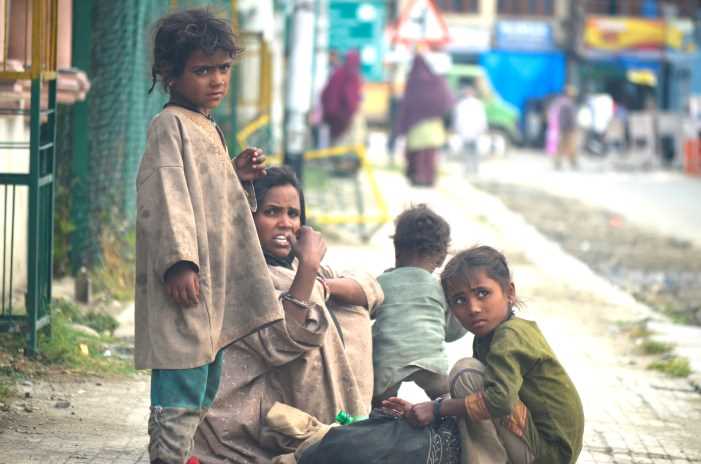
The Begging Nexus in Kashmir: A Serious Problem that Needs to be Addressed
Beggars and the Begging Nexus in Kashmir: An In-Depth Exploration of a Complex Social Issue
By: Javid Amin
Begging, a pervasive and complex social problem, has deep-seated roots in the picturesque region of Kashmir. For many years, this issue has persistently plagued the valley, casting a shadow on the lives of its residents. The multifaceted nature of begging in Kashmir is attributed to a myriad of factors, including poverty, lack of access to education, and high unemployment rates. In recent times, a disquieting phenomenon has emerged—the proliferation of organized begging nexuses that ruthlessly exploit vulnerable individuals, particularly children. These begging nexuses, operating with a sinister agenda, employ coercive tactics such as violence, intimidation, and the withholding of basic necessities to control their victims. As the situation escalates, Kashmir is facing the daunting challenge of dismantling these nefarious networks. This article embarks on a comprehensive journey to unravel the beguiling tapestry of begging in Kashmir, delving into the driving factors, consequences, and potential solutions to this intricate problem.
Begging in Kashmir: A Tale of Multiple Dimensions
The history of begging in Kashmir is deeply intertwined with the region’s socio-economic fabric. Poverty has long been a persistent issue, compounded by a lack of access to quality education and a dearth of employment opportunities. These factors have converged to create an environment where begging becomes not just a means of survival, but sometimes the only option for those grappling with destitution.
Over the years, the demographics of beggars in Kashmir have undergone a transformation. What was once primarily a refuge for the elderly and the infirm has evolved into a distressing scenario where children constitute a significant portion of the beggar population. This distressing shift in demographics underscores the alarming rise of begging nexuses—organized groups that systematically exploit these vulnerable individuals.
Begging Nexuses in Kashmir: Unmasking a Sinister Underworld
The term ‘begging nexus’ may be unfamiliar to many, but it encompasses a sinister and rapidly growing phenomenon in Kashmir. These are clandestine networks that manipulate, coerce, and force beggars, especially children, into begging for their gain. The methods employed by these begging nexuses are nothing short of abhorrent. Violence and intimidation are their tools of choice, as they use fear to control their victims. Withholding food, shelter, and other basic necessities is not beyond their repertoire, making escape from their clutches a Herculean task.
These begging nexuses have transformed begging from a solitary act of destitution into an organized crime. They operate with impunity, preying on the vulnerable and perpetuating the cycle of poverty. The victims, trapped in this nightmarish web, find themselves ensnared in a life devoid of dignity and hope.
A Spotlight on the Hot Spots: Where Beggars Thrive
To comprehend the gravity of the issue, one must recognize the geographical focal points of begging in Kashmir. These locations are akin to magnets, drawing beggars and sympathizers alike. Among these hot spots, some have become notorious for their ubiquity in the begging landscape.
Traffic Signals: The bustling intersections and traffic signals of Kashmir’s cities and towns have become prime locations for begging. Beggars, young and old, strategically position themselves here, knowing that these points are where people are most likely to pause during their journeys.
Bridges and Footbridges: The scenic footbridges that span the rivers and streams of Kashmir have also turned into hot spots for begging. The beauty of these locations draws tourists and locals alike, providing a captive audience for beggars.
Methods of Begging: Pulling at Heartstrings
Beggars in Kashmir, like their counterparts around the world, employ various tactics to elicit sympathy from passers-by. Understanding these strategies provides valuable insights into the psychology of begging in the region.
Using Children: Perhaps the most heart-wrenching aspect of begging in Kashmir is the exploitation of children. Beggars often carry infants or young children with them to evoke greater empathy from those they approach. This heart-rending sight can melt even the stoniest of hearts.
Feigning Disabilities: Another common strategy employed by beggars is feigning disabilities. Beggars may limp, use crutches, or even pretend to be visually impaired. These tactics are designed to tug at the compassion of passers-by.
The Impact of the Begging Nexus on Kashmir
The existence and unchecked growth of begging nexuses in Kashmir have far-reaching consequences, both for the victims and the region as a whole. Understanding these impacts is critical to comprehending the urgency of addressing the problem.
Exploitation of Vulnerable Individuals: The most immediate and heart-wrenching impact of begging nexuses is the exploitation of vulnerable individuals, particularly children. These innocent lives are ensnared in a cycle of coercion and abuse, robbed of their childhood and a chance at a better life.
Strain on Resources and Infrastructure: Kashmir, already grappling with various socio-economic challenges, faces an additional burden due to the proliferation of begging. Limited resources and infrastructure are stretched to their limits as the region struggles to provide support to those in need.
Tarnished Image: The negative impact of begging extends beyond its immediate victims. Kashmir, often celebrated for its natural beauty and rich culture, risks its image being tarnished by this issue. Tourists, a significant source of revenue for the region, may be deterred by the visible presence of begging nexuses.
Cracking the Code: Steps to Address the Begging Nexus
Addressing the begging nexus in Kashmir is a daunting task, but not an insurmountable one. It requires a multifaceted approach that tackles the issue at its roots and empowers individuals to break free from the cycle of begging.
Education and Vocational Training: One of the primary factors driving begging in Kashmir is the lack of education and employable skills. Providing education and vocational training to beggars can equip them with the tools needed to find alternative sources of livelihood.
Social Safety Nets: Establishing comprehensive social safety nets is essential to support the impoverished and vulnerable. These nets can include access to food, shelter, and medical care, ensuring that individuals do not turn to begging out of desperation.
Raising Awareness: Shedding light on the issue is the first step towards eradicating begging nexuses. Raising awareness about the existence and operations of these nexuses, particularly their exploitation of children, is crucial in garnering public support for action against them.
Law Enforcement: It is imperative that law enforcement agencies take proactive measures to dismantle organized crime groups that exploit beggars. This includes identifying and apprehending those responsible for running begging nexuses.
Case Studies: Illuminating Lives Impacted by the Begging Nexus
Case Study 1: Ali’s Story: A poignant narrative unfolds as we delve into the life of Ali, a young boy who was compelled to beg by his own parents. Each day, Ali would rise early, trudging to a busy traffic signal where he would spend hours begging. Heartbreakingly, his parents would confiscate every penny he earned. However, Ali’s life took a turn when a compassionate social worker intervened. He was rescued, provided with food, shelter, and access to education. Today, Ali thrives in school and nurtures dreams of breaking free from the clutches of the begging nexus.
Case Study 2: Fatima’s Journey to Freedom: Fatima’s harrowing journey began when she was trafficked to Kashmir from another state. Forced into begging by her trafficker, she endured unspeakable hardships, including physical abuse and threats if she failed to meet her daily ‘quota.’ One fateful day, Fatima managed to escape her tormentor. She was rescued by a vigilant police officer and found refuge in a shelter. Today, with counseling and support, Fatima is determined to rebuild her life.
A Call to Action
The begging nexus is a formidable challenge in Kashmir, exploiting the vulnerable and straining the region’s resources and image. However, it is a challenge that can be met with resolve and determination. The solutions lie in education, social safety nets, awareness, and law enforcement. As concerned individuals, we all have a role to play in making a difference. When confronted with a beggar, consider not offering money directly but instead donating to reputable charities actively working to help beggars and other vulnerable individuals in Kashmir. In unity and action, we can create a brighter, more compassionate future for Kashmir, one free from the clutches of begging nexuses.

